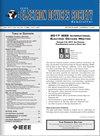A Temperature-Dependent SPICE Model of SiC Power Trench MOSFET Switching Behavior Considering Parasitic Parameters
IF 2
3区 工程技术
Q3 ENGINEERING, ELECTRICAL & ELECTRONIC
引用次数: 0
Abstract
The application of silicon carbide (SiC) MOSFETs in the field of high voltage and high frequency brings the major challenge of high switching loss. To give full advantage of its performance in high-frequency applications and provide a simulation analysis method for the analysis and design of power electronic systems, it is essential to establish simulation models of the SiC power MOSFET switching behavior suitable for different ambient temperatures. A temperature-dependent compact SPICE model considering parasitic parameters is proposed in this article, which uses only the parameters in the datasheet or provided by manufacturers. The main technology-dependent parameters are analyzed and discussed in detail, including the nonlinear parasitic capacitance, parasitic parameters of the power module, and static characteristic parameters. In static characteristics, a simple and continuous equation is used to describe the drain-source current of the SiC power MOSFET. The static characteristic parameters of the SPICE model were compared with the 1.2-kV SiC power MOSFET, manufactured by ROHM, Inc., (SCT3030KLHR). Subsequently, the dynamic characteristic is verified by comparing the simulation results with experimental results in a double pulse circuit employing the half-bridge module under different temperatures. Comparisons between the datasheet and experiments demonstrate the precision of the modeling methodology and the consistency of the results.考虑寄生参数的SiC功率沟槽MOSFET开关行为的温度相关SPICE模型
碳化硅 (SiC) MOSFET 在高电压和高频率领域的应用带来了高开关损耗的重大挑战。为了充分发挥 SiC 功率 MOSFET 在高频应用中的性能优势,并为电力电子系统的分析和设计提供仿真分析方法,必须建立适合不同环境温度的 SiC 功率 MOSFET 开关行为仿真模型。本文提出了一种考虑寄生参数的与温度相关的紧凑型 SPICE 模型,该模型仅使用数据手册中的参数或制造商提供的参数。文中详细分析和讨论了与技术相关的主要参数,包括非线性寄生电容、功率模块的寄生参数和静态特性参数。在静态特性方面,使用了一个简单的连续方程来描述 SiC 功率 MOSFET 的漏极-源极电流。SPICE 模型的静态特性参数与 ROHM 公司生产的 1.2 kV SiC 功率 MOSFET(SCT3030KLHR)进行了比较。随后,通过比较仿真结果和采用半桥模块的双脉冲电路在不同温度下的实验结果,验证了动态特性。数据表与实验结果的比较证明了建模方法的精确性和结果的一致性。
本文章由计算机程序翻译,如有差异,请以英文原文为准。
求助全文
约1分钟内获得全文
求助全文
来源期刊

IEEE Journal of the Electron Devices Society
Biochemistry, Genetics and Molecular Biology-Biotechnology
CiteScore
5.20
自引率
4.30%
发文量
124
审稿时长
9 weeks
期刊介绍:
The IEEE Journal of the Electron Devices Society (J-EDS) is an open-access, fully electronic scientific journal publishing papers ranging from fundamental to applied research that are scientifically rigorous and relevant to electron devices. The J-EDS publishes original and significant contributions relating to the theory, modelling, design, performance, and reliability of electron and ion integrated circuit devices and interconnects, involving insulators, metals, organic materials, micro-plasmas, semiconductors, quantum-effect structures, vacuum devices, and emerging materials with applications in bioelectronics, biomedical electronics, computation, communications, displays, microelectromechanics, imaging, micro-actuators, nanodevices, optoelectronics, photovoltaics, power IC''s, and micro-sensors. Tutorial and review papers on these subjects are, also, published. And, occasionally special issues with a collection of papers on particular areas in more depth and breadth are, also, published. J-EDS publishes all papers that are judged to be technically valid and original.
 求助内容:
求助内容: 应助结果提醒方式:
应助结果提醒方式:


